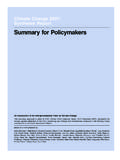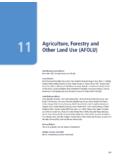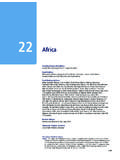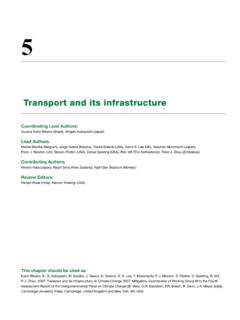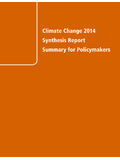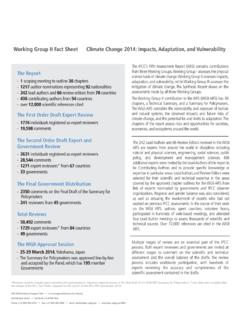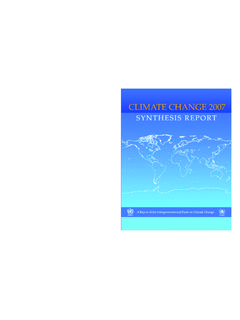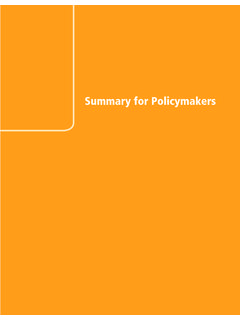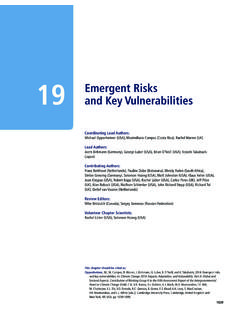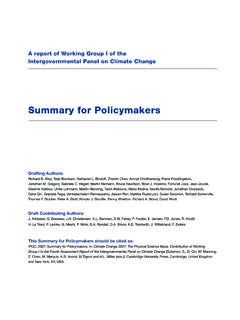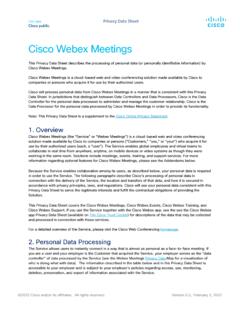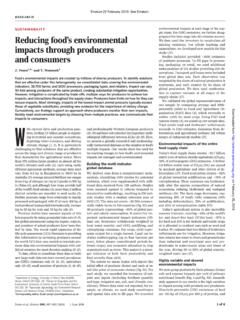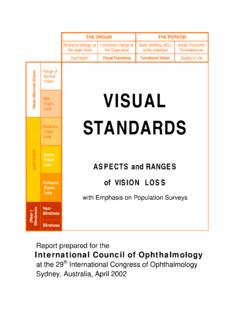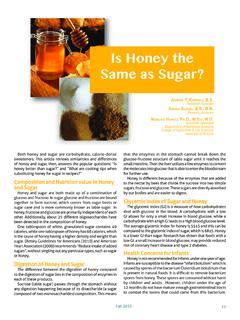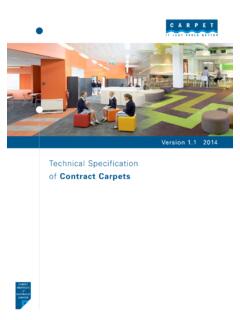Transcription of Mitigation Pathways Compatible with 1.5°C in the Context ...
1 932 Coordinating Lead Authors:Joeri Rogelj (Belgium/Austria), Drew Shindell (USA), Kejun Jiang (China)Lead Authors:Solomone Fifita (Fiji), Piers Forster (UK), Veronika Ginzburg (Russia), Collins Handa (Kenya), Haroon Kheshgi (USA), Shigeki Kobayashi (Japan), Elmar Kriegler (Germany), Luis Mundaca (Sweden/Chile), Roland S f rian (France), Maria Virginia Vilari o (Argentina)Contributing Authors:Katherine Calvin (USA), Joana Correia de Oliveira de Portugal Pereira (UK/Portugal), Oreane Edelenbosch (Netherlands/Italy), Johannes Emmerling (Italy/Germany), Sabine Fuss (Germany), Thomas Gasser (Austria/France), Nathan Gillett (Canada), Chenmin He (China), Edgar Hertwich (USA/Austria), Lena H glund-Isaksson (Austria/Sweden), Daniel Huppmann (Austria), Gunnar Luderer (Germany), Anil Markandya (Spain/UK), David L.
2 McCollum (USA/Austria), Malte Meinshausen (Australia/Germany), Richard Millar (UK), Alexander Popp (Germany), Pallav Purohit (Austria/India), Keywan Riahi (Austria), Aur lien Ribes (France), Harry Saunders (Canada/USA), Christina Sch del (USA/Switzerland), Chris Smith (UK), Pete Smith (UK), Evelina Trutnevyte (Switzerland/Lithuania), Yang Xiu (China), Wenji Zhou (Austria/China), Kirsten Zickfeld (Canada/Germany)Chapter Scientist: Daniel Huppmann (Austria), Chris Smith (UK)Review Editors:Greg Flato (Canada), Jan Fuglestvedt (Norway), Rachid Mrabet (Morocco), Roberto Schaeffer (Brazil)This chapter should be cited as:Rogelj, J., D. Shindell, K. Jiang, S. Fifita, P. Forster, V. Ginzburg, C. Handa, H. Kheshgi, S. Kobayashi, E. Kriegler, L. Mundaca, R. S f rian, and Vilari o, 2018: Mitigation Pathways Compatible with C in the Context of Sustainable Development.
3 In: Global Warming of C. An IPCC Special Report on the impacts of global warming of C above pre-industrial levels and related global greenhouse gas emission Pathways , in the Context of strengthening the global response to the threat of climate change, sustainable development, and efforts to eradicate poverty [Masson-Delmotte, V., P. Zhai, P rtner, D. Roberts, J. Skea, Shukla, A. Pirani, W. Moufouma-Okia, C. P an, R. Pidcock, S. Connors, Matthews, Y. Chen, X. Zhou, Gomis, E. Lonnoy, T. Maycock, M. Tignor, and T. Waterfield (eds.)]. In Pathways Compatible with C in the Context of Sustainable Development94 Chapter 2 Mitigation Pathways Compatible with C in the Context of Sustainable Development2 Executive Summary .. Introduction to Mitigation Pathways and the Sustainable Development Context .
4 98 Mitigation Pathways Consistent with C ..98 The Use of Scenarios ..98 New Scenario Information since AR5 ..99 Utility of Integrated Assessment Models (IAMs) in the Context of this Report .. Geophysical Relationships and Constraints ..101 Geophysical Characteristics of Mitigation Pathways ..101 The Remaining C Carbon Budget .. Overview of C Mitigation Pathways ..108 Range of Assumptions Underlying C Pathways ..109 Key Characteristics of C Pathways ..112 Emissions Evolution in C Pathways ..115 CDR in C Pathways ..118 Box : Bioenergy and BECCS Deployment in Integrated Assessment Modelling ..124 Implications of Near-Term Action in C Pathways .. Disentangling the Whole-System Transformation ..129 Energy System Transformation ..129 Energy Supply.
5 130 Energy End-Use Sectors ..136 Land-Use Transitions and Changes in the Agricultural Sector .. Challenges, Opportunities and Co-Impacts of Transformative Mitigation Pathways ..148 Policy Frameworks and Enabling Conditions ..148 Cross-Chapter Box 5 | Economics of C Pathways and the Social Cost of Carbon ..150 Economic and Investment Implications of C Pathways ..152 Sustainable Development Features of C Pathways .. Knowledge Gaps ..157 Geophysical Integrated Assessment Approaches ..158 Carbon Dioxide Removal (CDR) ..158 Frequently Asked Questions FAQ : What Kind of Pathways Limit Warming to C and are we on Track? ..159 FAQ : What do Energy Supply and Demand have to do with Limiting Warming to C? ..161 References ..163 Table of Contents952 Mitigation Pathways Compatible with C in the Context of Sustainable Development Chapter 2 Executive SummaryThis chapter assesses Mitigation Pathways consistent with limiting warming to C above pre-industrial levels.
6 In doing so, it explores the following key questions: What role do CO2 and non-CO2 emissions play? { , , , } To what extent do C Pathways involve overshooting and returning below C during the 21st century? { , } What are the implications for transitions in energy, land use and sustainable development? { , , } How do policy frameworks affect the ability to limit warming to C? { , } What are the associated knowledge gaps? { }The assessed Pathways describe integrated, quantitative evolutions of all emissions over the 21st century associated with global energy and land use and the world economy. The assessment is contingent upon available integrated assessment literature and model assumptions, and is complemented by other studies with different scope, for example, those focusing on individual sectors.
7 In recent years, integrated Mitigation studies have improved the characterizations of Mitigation Pathways . However, limitations remain, as climate damages, avoided impacts, or societal co-benefits of the modelled transformations remain largely unaccounted for, while concurrent rapid technological changes, behavioural aspects, and uncertainties about input data present continuous challenges. (high confidence) { , , , , Technical Annex 2}The Chances of Limiting Warming to C and the Requirements for Urgent ActionPathways consistent with C of warming above pre-industrial levels can be identified under a range of assumptions about economic growth, technology developments and lifestyles. However, lack of global cooperation, lack of governance of the required energy and land transformation, and increases in resource-intensive consumption are key impediments to achieving C Pathways .
8 Governance challenges have been related to scenarios with high inequality and high population growth in the C pathway literature. { , , }Under emissions in line with current pledges under the Paris Agreement (known as Nationally Determined Contributions, or NDCs), global warming is expected to surpass C above pre-industrial levels, even if these pledges are supplemented with very challenging increases in the scale and ambition of Mitigation after 2030 (high confidence). This increased action would need to achieve net zero CO2 emissions in less than 15 years. Even if this is achieved, temperatures would only be expected to remain below the C threshold if the actual geophysical response ends up being towards the low end of the currently estimated uncertainty range.
9 Transition challenges as well as identified trade-offs can be reduced if global emissions peak before 2030 and marked emissions reductions compared to today are already achieved by 2030. { , , Cross-Chapter Box 11 in Chapter 4}Limiting warming to C depends on greenhouse gas (GHG) emissions over the next decades, where lower GHG emissions in 2030 lead to a higher chance of keeping peak warming to C (high confidence). Available Pathways that aim for no or limited (less than C) overshoot of C keep GHG emissions in 2030 to 25 30 GtCO2e yr 1 in 2030 (interquartile range). This contrasts with median estimates for current unconditional NDCs of 52 58 GtCO2e yr 1 in 2030. Pathways that aim for limiting warming to C by 2100 after a temporary temperature overshoot rely on large-scale deployment of carbon dioxide removal (CDR) measures, which are uncertain and entail clear risks.
10 In model Pathways with no or limited overshoot of C, global net anthropogenic CO2 emissions decline by about 45% from 2010 levels by 2030 (40 60% interquartile range), reaching net zero around 2050 (2045 2055 interquartile range). For limiting global warming to below 2 C with at least 66% probability CO2 emissions are projected to decline by about 25% by 2030 in most Pathways (10 30% interquartile range) and reach net zero around 2070 (2065 2080 interquartile range).1 { , , , , Cross-Chapter Boxes 6 in Chapter 3 and 9 in Chapter 4, }Limiting warming to C implies reaching net zero CO2 emissions globally around 2050 and concurrent deep reductions in emissions of non-CO2 forcers, particularly methane (high confidence). Such Mitigation Pathways are characterized by energy-demand reductions, decarbonization of electricity and other fuels, electrification of energy end use, deep reductions in agricultural emissions, and some form of CDR with carbon storage on land or sequestration in geological reservoirs.
